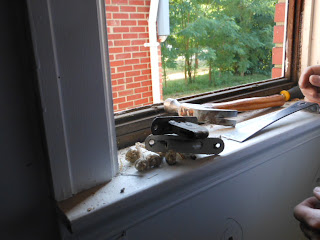PART ONE HOW TO REPLACE A WINDOW
I had hinted about a post on replacing double-hung windows, and Copperhead is holding me to it.
This
is the last window to be replaced on the house, the smallest (28" wide x
34" high--the others were either 36"x46" or 40"x54") and in the best
shape. This window is in the first floor bathroom, and faces north.
The windows on the east, west and south were missing glazing compound,
missing ropes, had broken glass, and storm window issues on more than
half of them--missing glass and even missing wood.
Another factor on replacing the windows rather than repairing them is the matter of the sash weight pockets. These amount to a 2" wide strip down each side of each window for the sash ropes and weights to operate in. This comes out to four inches by four to five feet of uninsulated wall for each window, multiplied by sixteen windows makes about a five-foot square hole in your insulation. These wood windows also had no weatherstripping at all. They were a tighter fit in the frames than some of the windows I have worked on from the early 1900s, but still not tight enough in these days of expensive energy.
Another factor was the lead paint issue. There has been a lot of noise and heat on that subject, but not really much light. Not all houses are equally hazardous in this respect. While using lead compounds in paint was not officially banned until 1978, the paint companies began using other pigments during World War II, because lead was needed for the war effort (my source on this was an old friend who worked as a paint chemist for a regional paint manufacturer). So it is less likely that this house, built around 1950, has as much lead-based paint that would be found on on a home built in the late 1800s or early 1900s. But if there is lead paint, it will be on woodwork and exterior wood, not on plaster or drywall. And the primary risk is not paint chips, which if swallowed will likely pass through undigested, but from paint dust generated by painted wood parts rubbing against each other--a window in its frame or a door that rubs on its jamb. Replacing the windows removes that possible source, if they should have lead-based paint under the later coats accumulated through the years.
Another factor on replacing the windows rather than repairing them is the matter of the sash weight pockets. These amount to a 2" wide strip down each side of each window for the sash ropes and weights to operate in. This comes out to four inches by four to five feet of uninsulated wall for each window, multiplied by sixteen windows makes about a five-foot square hole in your insulation. These wood windows also had no weatherstripping at all. They were a tighter fit in the frames than some of the windows I have worked on from the early 1900s, but still not tight enough in these days of expensive energy.
Another factor was the lead paint issue. There has been a lot of noise and heat on that subject, but not really much light. Not all houses are equally hazardous in this respect. While using lead compounds in paint was not officially banned until 1978, the paint companies began using other pigments during World War II, because lead was needed for the war effort (my source on this was an old friend who worked as a paint chemist for a regional paint manufacturer). So it is less likely that this house, built around 1950, has as much lead-based paint that would be found on on a home built in the late 1800s or early 1900s. But if there is lead paint, it will be on woodwork and exterior wood, not on plaster or drywall. And the primary risk is not paint chips, which if swallowed will likely pass through undigested, but from paint dust generated by painted wood parts rubbing against each other--a window in its frame or a door that rubs on its jamb. Replacing the windows removes that possible source, if they should have lead-based paint under the later coats accumulated through the years.
 |
| It does not take a lot of tools to handle this job. I think I left my small handsaw out of this picture, but I could get by without it by using the chisel. |
 |
| Put the pocket covers back into their places, and the window is removed. Cleaning up any dirt, dust or debris is next, and we are ready for the new window. |












Nice work...both on the window and on reporting it here on the blog!!
ReplyDeleteUndoubtedly, the first things to prepare in replacing windows are your tools. Then, you have to take measurements. The smallest measurements are used so your replacement windows fit within the opening. Avoid doing the task alone to prevent incurring injuries and or damaging the materials.
ReplyDeleteTameka Lauricella
Thanks for this post! It’s very helpful for every DIY-ers. =) It must be really tough to do window replacements. What do you suggest for a window pane material? I might try doing your instructions with my friend. I really feel like my living room window needs a replacement. Please keep us posted!
ReplyDeleteKermit Lukacs
Just by reading this blog post, I can tell that you're an expert when it comes to replacing windows and other DIY jobs for that matter. You even know the alternatives you can use if ever you don't have the certain tools to use in this kind of project. I wish you're house is just within reach, so I'll be able to ask you if I need help. Hehe!
ReplyDeleteAllyson Ripple